|
|
| UNIX in the 1990s-2002 - Was SCO the Market Leader? |
 |
|
Tuesday, February 24 2009 @ 06:26 PM EST
|
As you know, I've been going through all our records during a lull in SCO activity, trying to get Groklaw caught up so we can complete our preservation work. And we're making some progress. Here's something. I found a 2001 DH Brown comparative technical assessment of Unix players. Guess who was the UNIX leader? Sun Solaris won that year. HP won the following year. So exactly how is SCO a market leader in the first wave of UNIX beginning in the 1990s, as SCO alleged in its recent Disclosure Statement in its bankruptcy, followed by Linux in the next wave? IBM references SCO's claims on page 18 of IBM's Objections [PDF] to SCO's Motion to Approve Disclosure Statement. IBM quotes SCO: If one were to think about the landscape of UNIX-based application platforms, SCO would be the clear leader in the first wave with 43% market share in the 1990s. The second wave would see Linux at the forefront being led by IBM.
SCO's UnixWare came in dead last overall, as I'll show you in some
screen shots I took for you, because the 2001 DH Brown report is no longer available online, that I could find. At the time, the executive summary was free to the public. But you know me and copyright law. I try to be a good do-be, so I'll just show you just some fair use bits and pieces. You can purchase the complete report from DH Brown. So, fair warning to those of you on dial up -- graphics ahoy!
UnixWare only got an OK rating, dead last, in the Executive Summary:
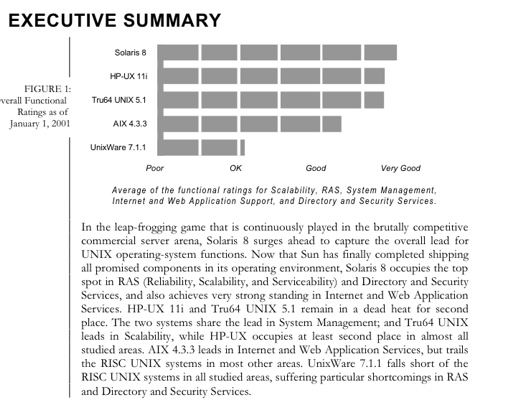
You can still read the press release, by the way, in a couple of places: D. H. Brown Associates, Inc. (www.dhbrown.com) has released its 2001 UNIX Function Review, a detailed technical assessment of the functional capabilities of five leading UNIX operating systems.
The study employed more than 115 technical criteria to rank the systems across five major functional areas: Scalability; Reliability, Availability, and Serviceability (RAS); System Management; Internet and Web Application Services; and Directory and Security Services. The studied systems include Compaq's Tru64 UNIX 5.1, Hewlett-Packard's HP-UX 11i, IBM's AIX 4.3.3, Santa Cruz Operation's UnixWare 7.1.1, and Sun Microsystems' Solaris 8.
SCO ranked high in terms of Linux interoperability, but so did Solaris, according to the 2001 UNIX Function Review, but in everything else, SCO was definitely not the leader. As for market share, I think any SCO claims relate to Unix *on Intel*, not to the market as a whole:
UNIXWARE 7.1.1: Santa Cruz Operation (SCO) historically dominated the UNIX-on-Intel market with over 85% of marketshare and a deep understanding of the platform. SCO achieved its position through its long-standing OpenServer product. This product generated a respectable set of third-party solutions for meeting small-business requirements. More important, SCO gained expertise in supporting the vast and diverse array of hardware that permeates the Intel X86 landscape, offering a competency matched only by Microsoft. In recent years, SCO has focused on the more advanced UnixWare, which it acquired from Novell in 1996. UnixWare is an implementation of System V Release 5 (SVR5) with PC-oriented networking extensions, integrated Internet connectivity, and enhancements targeting reliability and scalability.
UnixWare 7 allowed SCO to make the leap from targeting small-to-medium-sized businesses to become a serious UNIX competitor, poised to take on enterprise requirements. However, despite its early success in lining up OEM partners, SCO was unable to continue the investments in UnixWare required to compete with the heavyweight UNIX systems from Sun, HP, IBM, and Compaq. SCO announced in late 1998 that it would no longer position UnixWare as an enterprise platform when IA-64 arrived, choosing instead to embrace the AIX kernel as the foundation for the next-generation “Monterey” product.
Since then, SCO took a step further and announced that it would sell all of its UNIX products, including OpenServer and UnixWare, to Caldera Systems Inc., a leading Linux-distribution supplier. The transaction has not yet been completed, but Caldera has stated that it will sustain SCO’s efforts to enhance UnixWare for IA-32 platforms, which will remain relevant for some time until IA-64 enters mainstream markets. Caldera also plans to introduce a “Linux Kernel Personality” (LKP) for UnixWare that will allow it to run Linux applications. Caldera plans to position UnixWare as a kind of super-charged Linux environment that is fully compatible with other Linux distributions, but has more powerful functions under the hood than the traditional Linux kernel. To deliver on this promise, however, Caldera will have to marshal sufficient development resources to keep up with the investments of the established enterprise competitors....
UnixWare’s scalability fundamentally depends on the capabilities of the Intel server architecture, which will not complete its transition to 64-bits until later this year. UnixWare supports state-of-the-art enterprise servers based on current IA32 processors, including the Unisys ES7000, a mainframe-class machine that can be configured with up to 32 processors and up to 64 GB of memory. 10 Although UnixWare supports all 32 processors in ES7000, the maximum SMP configuration for which UnixWare has produced credible database-benchmark evidence on is eight processors. Like AIX and Solaris, UnixWare supports file systems and files up to one TB....
UnixWare supports up to 32 processors in SMP systems, but very few Intel X86based servers currently support more than eight processors. TPC-C results for UnixWare have only been produced on an eight-way server (41,085 tpmC on the Unisys ES2085R). However, Unisys recently began shipping a 32-way ES7000 server that supports UnixWare, so more competitive results may well appear in the future.
AIX, HP-UX, Solaris, and Tru64 UNIX have all run natively on 64-bit processors for years, and have been fully tuned and optimized for their respective environments (see Table 3 below).
Sound like UnixWare was leading the pack? Or OpenServer, for that matter? Or does it sound like a niche product for small to medium businesses on Intel, while the big boys took the rest of the market, the large enterprise customers? So, it comes down to how you define market share. Are you talking numbers of customers, without looking at size of the business or the hardware? Or are you talking about the entire Unix market? It would yield different results, I gather. For example, UnixWare isn't even on the list of supercomputing on page 24 of the DH Brown report. And UnixWare lacked certain functionality that all the others had. For example, the report says "All of the systems except UnixWare allow their respective Windows NT networking services to be protected with HA clustering tools." That's on page 65. And on page 67, it says that all the others, except UnixWare, supported cryptographic hardware:All of the studied systems except UnixWare support cryptographic hardware, which offloads the encryption task to special-purpose processors, boosting the scalability of secure websites. Indeed, SCO has historically focused on supporting departmental and small-business applications using traditional access methods such as terminals, and UnixWare includes relatively few tools for managing enterprise networks or web-based infrastructures. UnixWare offers very little support for LDAP, runs the fewest non-LDAP directory services, and includes none of the studied network security functions except for TCP/IP wrappers....All of the studied systems except UnixWare include at least one directory service that is compatible with LDAP V3 (UnixWare still provides an LDAP V2 server). ...
All of the systems except UnixWare allow the LDAP directory service to be integrated with the user login mechanism in the UNIX base operating system. Here's a tidbit about APIs: Application Program Interface (API) Compatibility: Although Linux APIs are very similar to those of the studied UNIX systems, there are enough divergences in the names, syntax, and semantics that porting issues will inevitably arise. To overcome these barriers, some UNIX vendors have launched efforts to implement the Linux APIs on their systems as faithfully as possible 45, seeking to allow applications to be recompiled on their platforms with relatively few hitches. The GNU tools and compilers mentioned earlier are of course important for this purpose as well.
UnixWare and the Intel X86 version of Solaris 8 46 each have the ability to actually run existing Linux binaries by including the lxrun tool. UnixWare will strengthen its compatibility for Linux applications with the introduction of its Linux Kernel Personality (LKP) due in the next release scheduled for June of this year, which provides support for a full Linux distribution using the UnixWare 7 kernel. UnixWare 7.1.1 also supports device drivers written to the Uniform Driver Interface (UDI) Version 1.01. Device drivers written to UDI work without recompilation across a number of platforms, including UnixWare, Linux 2.2, and AIX 5.1. UDI support helps Independent Hardware Vendors (IHV’s) who can reduce their investment in device-driver maintenance by writing to UDI. UDI also allows for more advanced execution and protection environments, so that a driver written to UDI that misbehaves cannot, if running in such an environment, bring the entire system down as is the case in most native driver interfaces.... All of the studied systems except UnixWare can also integrate the LDAPdirectory service with their e-mail functions, allowing the sendmail that is included in the base-operating system to perform LDAP X.500 directory lookups. Solaris and Tru64 UNIX also integrate LDAP services with printing.... All of the studied systems support TCP/IP wrappers, and all of the systems except UnixWare provide trusted TCP/IP commands.
Let's look now at some of the graphics, because it will give you a clear picture of where UnixWare really stood in comparison with the others.
Internet:
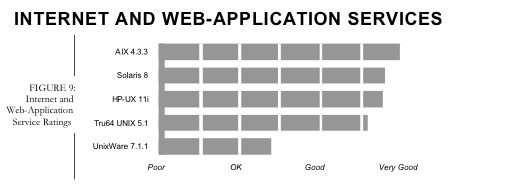
Reliability:
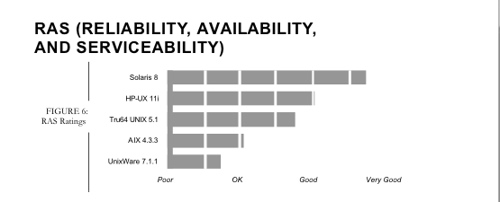
Security:
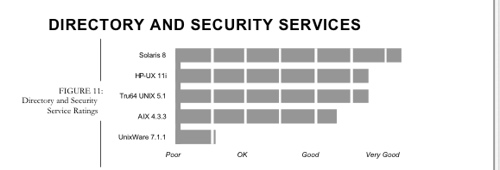
System Management:
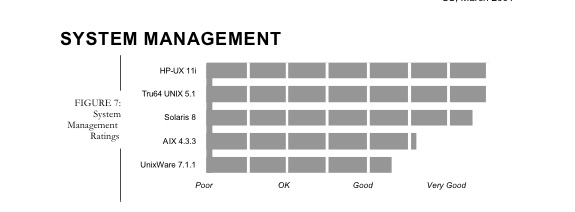
Tools:
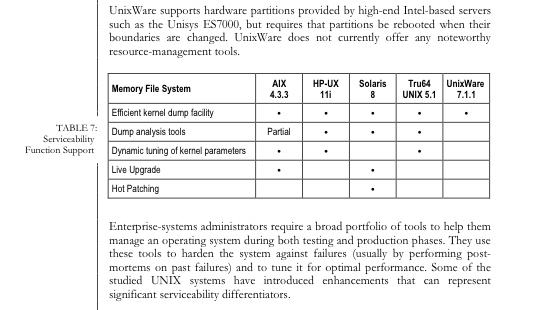
Get the true picture? In other progress, all the Comes v. Microsoft exhibits are available now as PDFs, as are the Minnesota antitrust litigation exhibits from Gordon v. Microsoft. We're still working on completing the posting of a description of each of them, but at least the PDFs are there now. You can always find the links to these exhibits from our permanent MS Litigation page.
Update: Q: There is also an interview with SCO's then President of Server Division David McCrabb, dated May 5, 2000 on Slashdot, which includes this tidbit: Q:
Will SCO be contributing / open-sourcing any technology and/or patents that it holds as part of its Linux adoption effort?
Also, did your market research pan out - is Linux really being used in large businesses or is it still primarily used by small startup companies strapped for cash?
McCrabb:
SCO is accelerating its participation in, and contributions to, the Open Source Community. In some cases, we will be taking current technology that we think is needed in the Linux market and driving it forward as the project maintainers. Right now, we are focusing on bringing some of our high-performance Intel development tools to Linux.
|
|
|
|
| Authored by: bprice on Tuesday, February 24 2009 @ 06:38 PM EST |
If needed.
---
--Bill. NAL: question the answers, especially mine.[ Reply to This | # ]
|
| |
| Authored by: bprice on Tuesday, February 24 2009 @ 06:39 PM EST |
Please consider using an open article for News Picks Commentary.
---
--Bill. NAL: question the answers, especially mine.[ Reply to This | # ]
|
| |
| Authored by: bprice on Tuesday, February 24 2009 @ 06:40 PM EST |
Please consider using an open article for Off Topic Comments: should your
comment be limited to Groklaw members.
---
--Bill. NAL: question the answers, especially mine.[ Reply to This | # ]
|
| |
| Authored by: hAckz0r on Tuesday, February 24 2009 @ 06:51 PM EST |
I could have guessed they would be good at that. I personally dumped UnixWare so
quickly I never needed that tool.
---
DRM - As a "solution", it solves the wrong problem; As a "technology" its only
'logically' infeasible.[ Reply to This | # ]
|
| |
| Authored by: ChrisP on Tuesday, February 24 2009 @ 08:21 PM EST |
As we know from Darl's testimony, Unixware is the trunk and Solaris and AIX are
the leaves of the UNIX tree. Given that Solaris and AIX have 50% of the current
market share, that certainly makes Unixware the current market leader! :-)
---
SCO^WM$^WIBM^W, oh bother, no-one paid me to say this.[ Reply to This | # ]
|
| |
| Authored by: JamesK on Tuesday, February 24 2009 @ 09:25 PM EST |
"SCO announced in late 1998 that it would no longer position UnixWare as an
enterprise platform when IA-64 arrived, choosing instead to embrace the AIX
kernel as the foundation for the next-generation “Monterey” product"
This must be how IBM stole Unix code to put into Linux. ;-)
---
There are 10 kinds of people in the world, those who understand binary and those
who don't.
[ Reply to This | # ]
|
| |
| Authored by: trevmar on Wednesday, February 25 2009 @ 02:28 AM EST |
I clearly remember that I considered SCO only to be of interest because of its
x86 platform target. I always saw it as a second-rate product. I remember I used
to drive by their buildings down here in Calabasas (So. California) circa. 1994,
and wonder how their product could support even that level of infrastructure.
However, there was no comparison between those several two(?)-story buildings
and the edifices at Sun or MIPS or HP...
[ Reply to This | # ]
|
| |
| Authored by: ingvar on Wednesday, February 25 2009 @ 04:31 AM EST |
During most of the 1990s, SCO had one of the few (thouhg I don't believe, at any
time, "the only") commercial x86 unix. At the beginning of the time
period, there was Interactive 386/ix as a strong contender. For a while, Sun had
an x86 offering, this was in the transition period of SunOS going from
"mostly BSD" to "mostly SysV". IBM had early versions of AIX
ported to the x86 platform (it was one of the offered OSes on the early PS/2).
But, the only constant offer through the time period, as I recall it, was
Xenix/SCO Unix/Unixware, so with sufficient "x86 is the only thing that
matters" blinds on, I can see how someone would decide that they were,
indeed, the leading unix vendor...[ Reply to This | # ]
|
| |
| Authored by: IMANAL_TOO on Wednesday, February 25 2009 @ 05:20 AM EST |
A DH Brown report for 1998-1999 similar to the one cited,
wrote:
"DHBA must emphasize that this report represents a
technology assessment, which exposes findings that remain distinct from other
types of research, such as market share statistics, customer satisfaction
surveys, or laboratory-based stress testing. One cannot extrapolate the
results
of this assessment to make conclusions in other domains. The industry has
frequently shown that the best technology does not always win in the market
place"
From an analysis called "What does Sun have to fear
from Linux? Linux may be setting its sights on Windows NT, but commercial Unix
vendors could get caught in the cross fire" by Steven Brody for Sunworld (sunsite.uakom.sk/sunworldonline/swol-12-1998/swol-12-linuxunix.html
):
The company with the most to lose to Linux may be SCO
(Santa Cruz Operation Inc.), the biggest player in the Unix OS market, according
to Martin Marshall, industry analyst at Zona Research Inc. SCO's UnixWare is a
Unix OS designed specifically to run on Intel-based machines, just like Linux.
Not only is Linux free, observes Marshall, but it makes for an easy transition
from other Unix platforms.
"SCO has found something of a white knight
in IBM," he said, referring to recent codevelopment agreements between SCO and
Big Blue, "but the kind of people flowing toward Linux will be Unix people, who
are most familiar and comfortable with that kind of OS."
SCO is also a
player in small workgroups operating on cheap Intel-based machines, said Robert
Berger, president of Internet Bandwidth Development (IBD), a Saratoga, CA-based
consulting firm. In that market, there may be no reason not to go with the
cheaper OS.
"Linux has traditionally been in LAN multiuser embedded
business systems. SCO is very vulnerable there to Linux. I can't think of a
reason to choose SCO over Linux for that kind of application. That's one major
area where Linux will impact traditional Unix," said Berger.
I am not sure what was behind Martin Marshall's
judgement of SCO as the "biggest player". Possibly he was just misinformed. I am
not so sure, however.
According to a quote from a no longer working link
("http://www.citrix.com/news/releases/prSept1798.htm") to Citrix found at: bat8.inria.fr/~la
ng/libre/reperes/index1999.html
"Citrix Ships New ICA®
Clients for LINUX and SCO UNIX press release, Citrix Systems, Inc. September
17, 1998. - Citrix's new ICA Clients for LINUX and SCO UNIX can be downloaded at
no charge from the company's website, located at http://download.citrix.com, for
use with Citrix WinFrame and MetaFrame server software. ... "With our new ICA
Clients for LINUX and SCO UNIX, we now support every major version of UNIX,..."
The ICA Client for LINUX was developed for the RedHat 5.1 platform. According to
1998 IDC figures, SCO OpenServer and UnixWare accounted for more than 40 percent
of the worldwide UNIX licenses shipped in 1997."
That Linux was
succesful at the time is also clear from Stephen Shanklands report http://news.cnet.com/2100-1001
-219214.html: "Linux shipments up 212
percent":
Shipments of licenses for server operating
systems increased 25 percent from 3.5 million in 1997 to an estimated 4.4
million in 1998. That means IDC counted about 236,000 Linux shipments in 1997
and 748,000 in 1998.
As always, and as noted by the
DH Brown report, success can be measured in many ways. The revenue is one
measure and market share is another. And, I am not convinced that they
necessarily go hand in hand.
I guess that the "desktop OS" revenue for the
MacOS by Apple Inc. is higher than that for "Linux", despite "equal market
share" in some markets. But, I am not sure.
Being the "Market leader" as SCO
claimed, to me is marketing talk, with little or no substance. That rings a bell
- "with little or no substance". It sounds very familiar, so very SCO to
me.
---
______
IMANAL
. [ Reply to This | # ]
|
| |
| Authored by: ka1axy on Wednesday, February 25 2009 @ 07:04 AM EST |
When I was at Data General, we did a project with Bridge Communications (bought
by 3Com in 1987). It was an Ethernet terminal server board for the MV series of
32 bit machines.
The Bridge product used SCO Xenix on a PC to run as an administration
workstation for the network. As I recall, they used SCOs product because it was
"real UNIX", unlike some of the other vendors' products...I forget all
the competitors' names. Since this was running on 386 machines, we weren't very
impressed with it, but for Bridge, it was perfect, because they could use code
that previously ran on a larger UNIX machine.
[ Reply to This | # ]
|
| |
| Authored by: yscydion on Wednesday, February 25 2009 @ 09:49 AM EST |
SCO may have been the leader in Unix sold separately as software. As far as I
can tell (and remember) the big money was carved up between Sun, HP and IBM who
were selling systems to run their various versions of Unix with the O/S included
and there was very little selling of Unix as software in its own right in that
market.
All the players were picking some way of looking at the figures
that made them come out on top and the market research and analysis companies
seemed happy to produce all sorts of different arrangements of the figures to
make that possible.
I would not be at all surprised if there was some
category where SCO could claim to be the market leader. That does not mean that
any competitor wanted to knock them off that spot and that is perhaps a first
measure of whether that position is worth anything. [ Reply to This | # ]
|
| |
| Authored by: caecer on Wednesday, February 25 2009 @ 10:15 AM EST |
| Somebody might care to follow up on some
1993 biz.sco.general newsgroup discussions of SCO's market
share. [ Reply to This | # ]
|
| |
| Authored by: sk43 on Wednesday, February 25 2009 @ 08:06 PM EST |
... the D.H. Brown report covers technology leadership, not market leadership:
"DHBA must emphasize that this report represents a TECHNOLOGY assessment,
which exposes findings that remain distinct from other types of research, such
as MARKETSHARE statistics, customer-satisfaction surveys, or laboratory-based
stress testing. One cannot extrapolate the results of this assessment to draw
conclusions in other domains. The industry has frequently shown that the best
technology does not always win in the marketplace."
As an example of the last sentence, Tru64 UNIX 5.1, which ranks ahead of
UnixWare, was DEC's version of UNIX, until DEC was sold to Compaq in 1998, which
itself was sold to HP in 2001. HP recommends that users migrate to HP-UX.
The report is also hardly complete - it ignores SGI's IRIX, which was also a
very capable 64-bit UNIX that, for a time, powered many of the leading
supercomputers.
As far as MARKETSHARE, we can actually do some research.
Amendment 1 to the APA includes the "UNIT PLAN" by which SCO would pay
a share of UnixWare, Eiger, Merged Product, and White Box royalties back to
Novell:
http://www.groklaw.net/article.php?story=20031208000408482
The chart at the bottom of the page shows the current and projected unit sales
for 1995 to 2002. Since the Bill of Sale was not signed until December of 1995,
we can presume that the figures for this year refer to pre-APA sales, and that
the numbers for SCO all refer to OpenServer. We see that SCO's projected unit
sales were 216,000 out of 1,360,000 total. This is just under 20%, well short
of SCO's claim of 43%, and it likely excludes Solaris sales (since Sun had
already completed its buyout), but if one added in the later UnixWare sales that
SCO made and summed over the entire decade, perhaps it is possible that SCO's
unit sales matched its claim.
Oh yes ...
1. Everyone I know who used AIX hated it.
2. I have never used or even seen in action either OpenServer or UnixWare.[ Reply to This | # ]
|
| |
| Authored by: wharris on Thursday, February 26 2009 @ 12:57 AM EST |
If we remember that the early 1990s predated Linux (more accurately,
predated Linux's becoming popular) then their claims make more sense.
Before newSco, before Caldera, there was Santa Cruz Operations, a respected
(though perhaps not fantastically successful) Unix distributor with an active
project of making an x86 version of Unix. If we restrict "market
leader" to be
true POSIX-certified Unix on x86 machines, I can readily believe that they
were the leading supplier.
Of course since then, FreeBSD and later Linux ate their lunch. After a failed
plan to "Unify" Linux and Unix, old-Sco (now called Tarantella) sold
the whole
shebang to Caldera, now called SCO. [ Reply to This | # ]
|
| |
| Authored by: Maple Syrup on Thursday, February 26 2009 @ 08:22 PM EST |
I was an employee of OldSco during the 90's, and I can attest that we really
*were* the market leader on x86 hardware during that time. Our major
competitors over the years were Interactive, Consensys, and Dell (really!), but
none of them ever came close to us in terms of market share or functionality.
I also believe that none of HP, Sun, or IBM (AIn't uniX) sold their OS
separately - you bought their expensive hardware and the OS came along for free.
Here's a quote from none other than Eric Raymond in 1994:
"... but at 70% of the market SCO must be doing something right."
Ref: http://www.catb.org/~esr/faqs/clone-unix-guide.txt
Also note the headcount numbers from the same document: SCO is listed with 60+
support engineers and 55+ development engineers: second place for development is
UHC with 27, and second place for support is Univel with 5.
Just another data point.
-Maple(I was there before the scum took it over)Syrup
[ Reply to This | # ]
|
|
|
|
|



